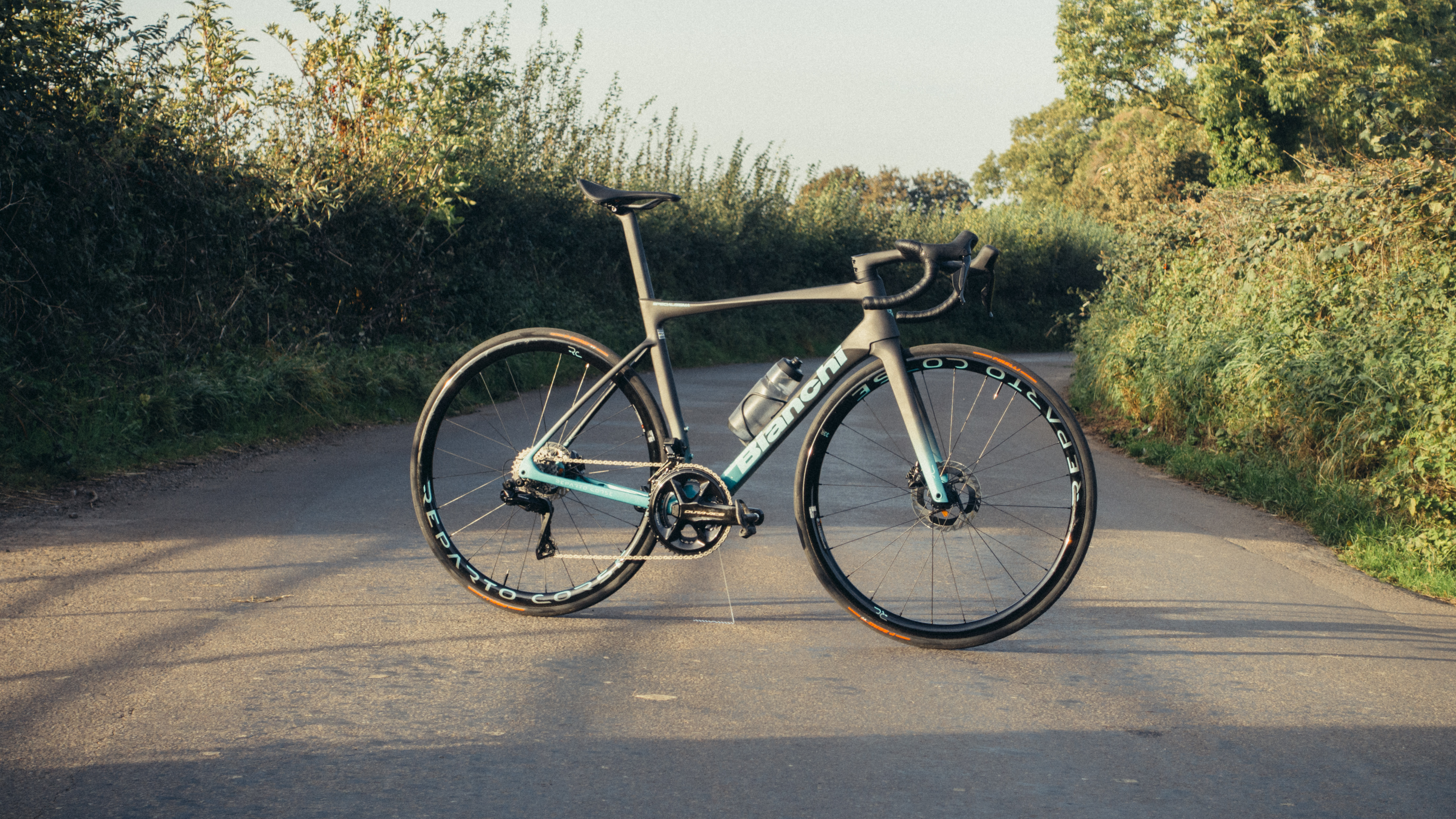Cyclingnews Verdict
Bonkers light, crazy fast, and a little jittery sometimes too, but does well to justify its price tag compared to some of its compatriots.
Pros
- +
Extremely low weight
- +
Decently aero too
- +
Just silly fast on basically any road
Cons
- -
Needs an inline seatpost
- -
Narrow TT tyres are sketchy
- -
Lacks that intangible Italian desirability factor
You can trust Cyclingnews
Price: €12,749
Size: 47, 50, 53, 55 (tested), 57, 59cm
Weight: 6.56kg
Groupset: Shimano Dura-Ace Di2
Wheels: Reparto Corse RC Carbon 33
Tyres: Pirelli P-Zero TT 26mm
Bar Stem: Reparto Corse 110mm x 40cm
Saddle: Bianchi RC139
I get to test a lot of the best road bikes on the market at this job. The majority tend to sit between £2k and abut £8k, the sort of bike prices that consumers can reasonably be expected to pay for anything from a pretty sorted entry level road bike up to fully fledged racing machines. Infrequently though I get to swing a leg over what people tend to refer to as ‘superbikes’. Until now I’d only tested three of those, two top-end Colnago machines and a custom titanium Sturdy. Now it’s the turn of another Italian machine, the Bianchi Specialissima, the top of the range Reparto Corse (RC) model, fully decked out with Shimano Dura-Ace Di2 to the tune of €12,749 and a weight of 6.56kg by my scales, before adding pedals, a computer mount, or bottle cages. That’s €1.94 for every gram of mass.
In 2022 the brand launched it’s new extremely aero-focussed Oltre RC, complete with UCI-illegal wind scoops on the head tube. The Specialissima has previously been the brand's de facto climbing bike, and while the headline weight figure certainly appears to be keeping that tradition alive Bianchi has made much of the aero improvements, billing the Specialissima now as a true all-rounder, in the same vein as the new Specialized Tarmac SL8, the new Canyon Ultimate, the new Cannondale SuperSix Evo, and basically every new top-end road bike that has come out in the last 12 months.
I’ve given it a thorough going over in the last few weeks. Up hills, on the flat, and on partially flooded British country lanes bestrewn with leaf mulch, cattle effluent, and the occasional dead pheasant; absolutely what Bianchi envisaged for this bike I’m sure. Beyond a certain price, and from certain brands in particular, a bike does become a status symbol, something I address in my review of the Colnago C68. There are echoes of that here, but it feels much more like a bike destined for the podium than the Colnago.
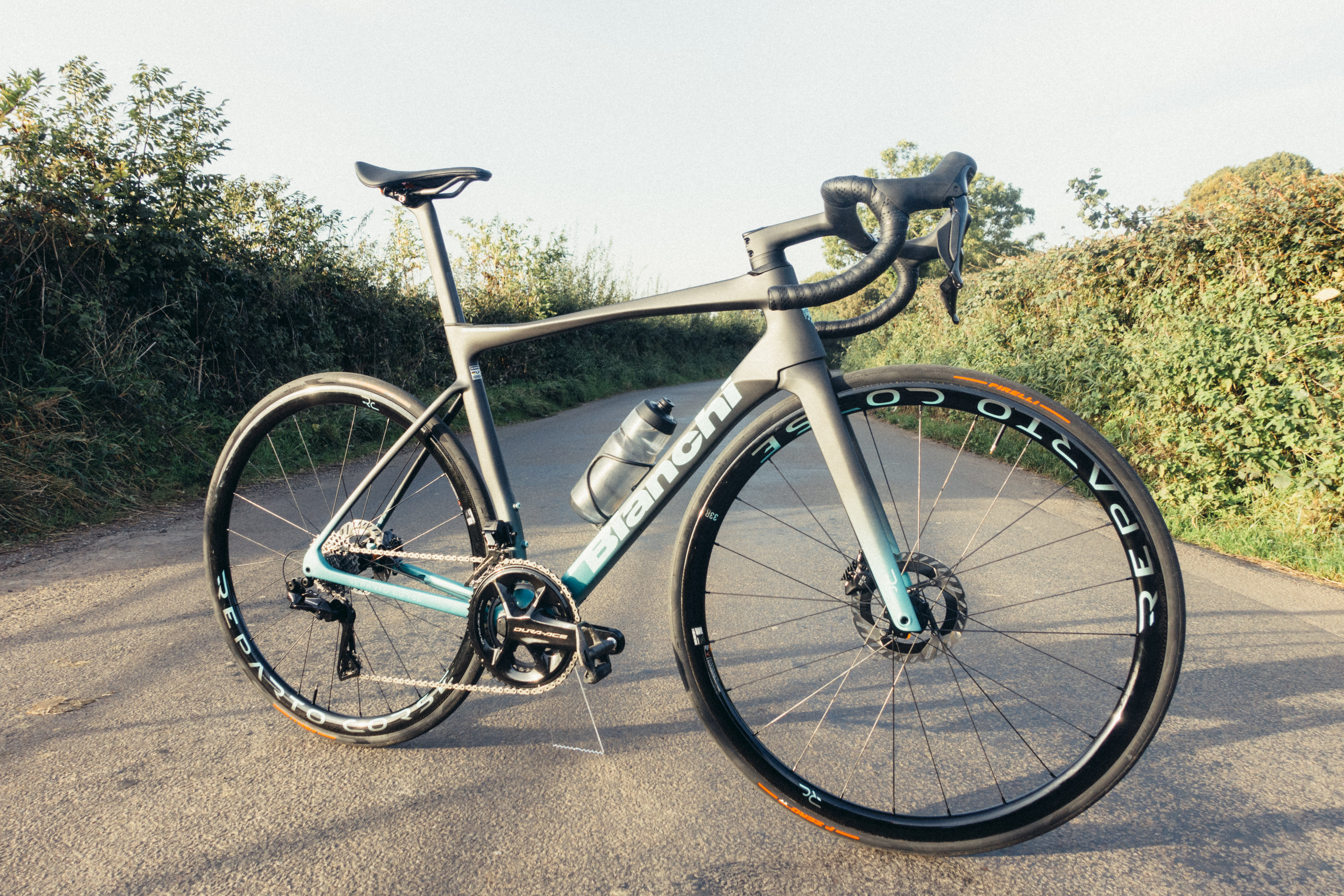
Design and aesthetics
I’m really torn on how this bike looks. On some days I’m convinced it’s gorgeous. Purposeful and angular, but not nearly so striking as the Oltre (a bike I do think is ugly as sin). It’s as if the Oltre worked hard to mentally soften my cranium up to this new-look Bianchi silhouette. On other days I dislike it. I think if it wasn’t Italian I’d be less against the angularity, and so with that in mind I think I’m going to fall on the side that objectively I quite like the way it looks.
I don’t much care for the “Reparto Corse” text on the non-driveside downtube; it makes it look a little like an AliExpress knockoff to those unfamiliar with the Milanese brand’s skunkworks division. Also, while the matte paint looks fine in my opinion, the combination of matte paint and gloss wheels is a little jarring. An entirely unscientific straw poll of my clubmates revealed the prevailing opinion that the bike looks a little dated, despite being thoroughly modern. The shapes hark back to the early days of aero, reminiscent of the original Specialized Venge and Giant Propel.
Subjective aestheics aside there’s a lot of design work to cover, the most pressing of which is the weight. Oddly the press release quoted the 6.6kg weight figure with a +/-5% margin of error, which means it could have been anywhere from 6.93kg to 6.27kg. I was happy to discover the scales tipped over at 6.56kg without the cages, pedals, or the included computer mount, making it the lightest bike I’ve ever tested and the only UCI illegal one too. Much of this weight saving has been achieved at the rear end of the bike, much like the Tarmac SL8. The seat stays are surgically thin compared to the outgoing model, and while the same crash diet hasn’t applied to the chain stays, they too are slimmer. The seatpost wedge and even the derailleur hanger have been milled out to shave a handful of grams. This is why it only felt right to fit the lightest of the bottle cages I had left over from creating the best bottle cages buyer’s guide.
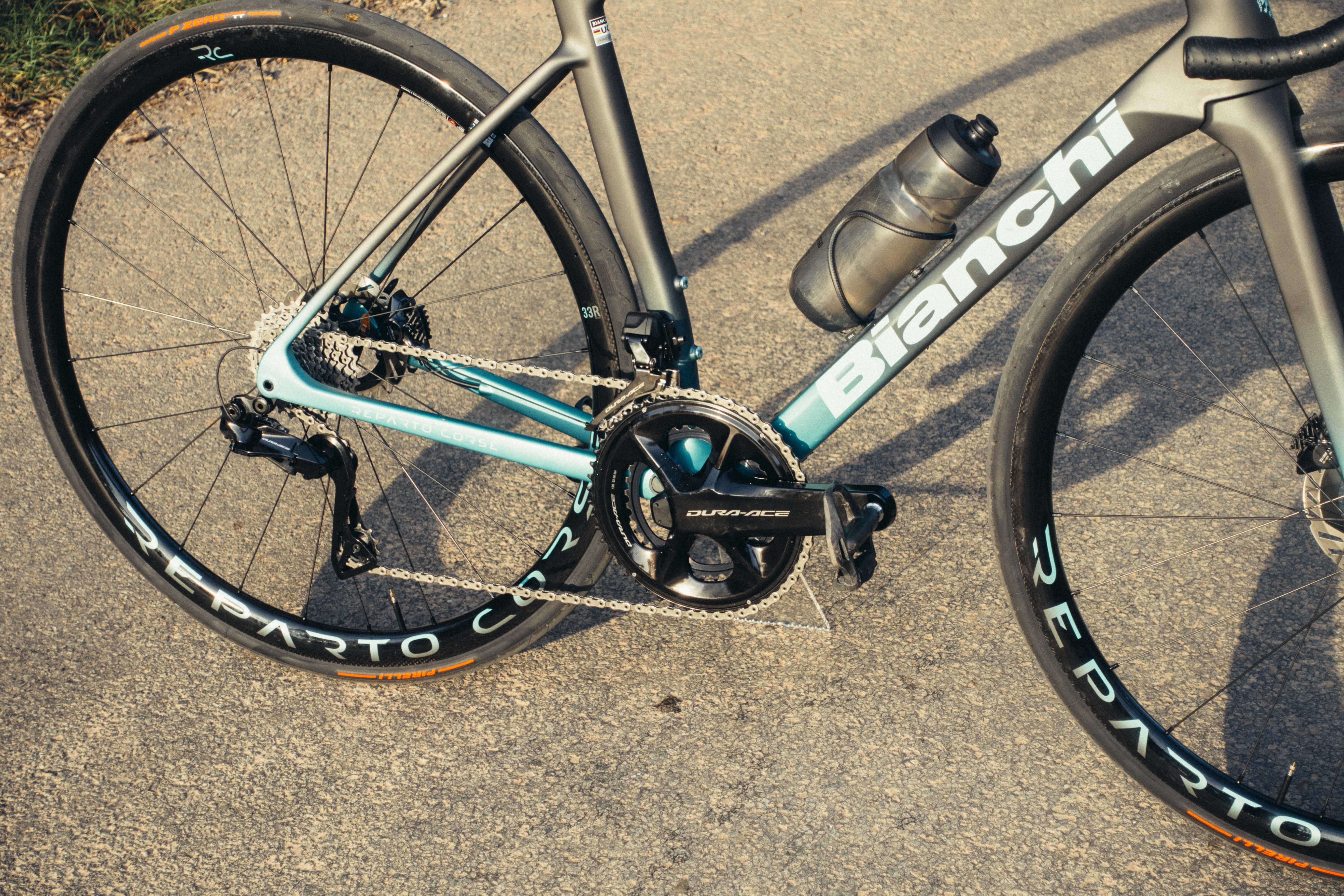
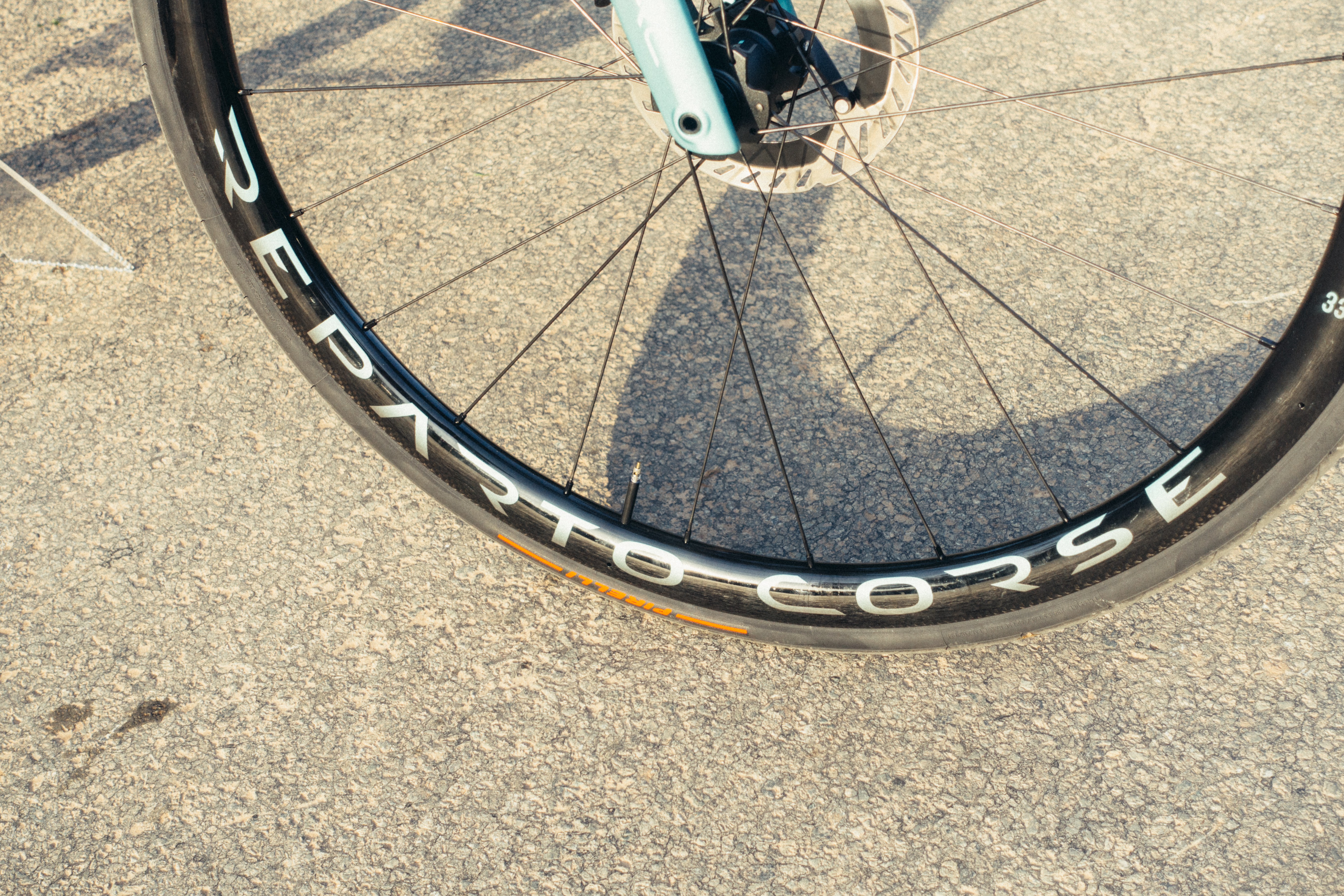
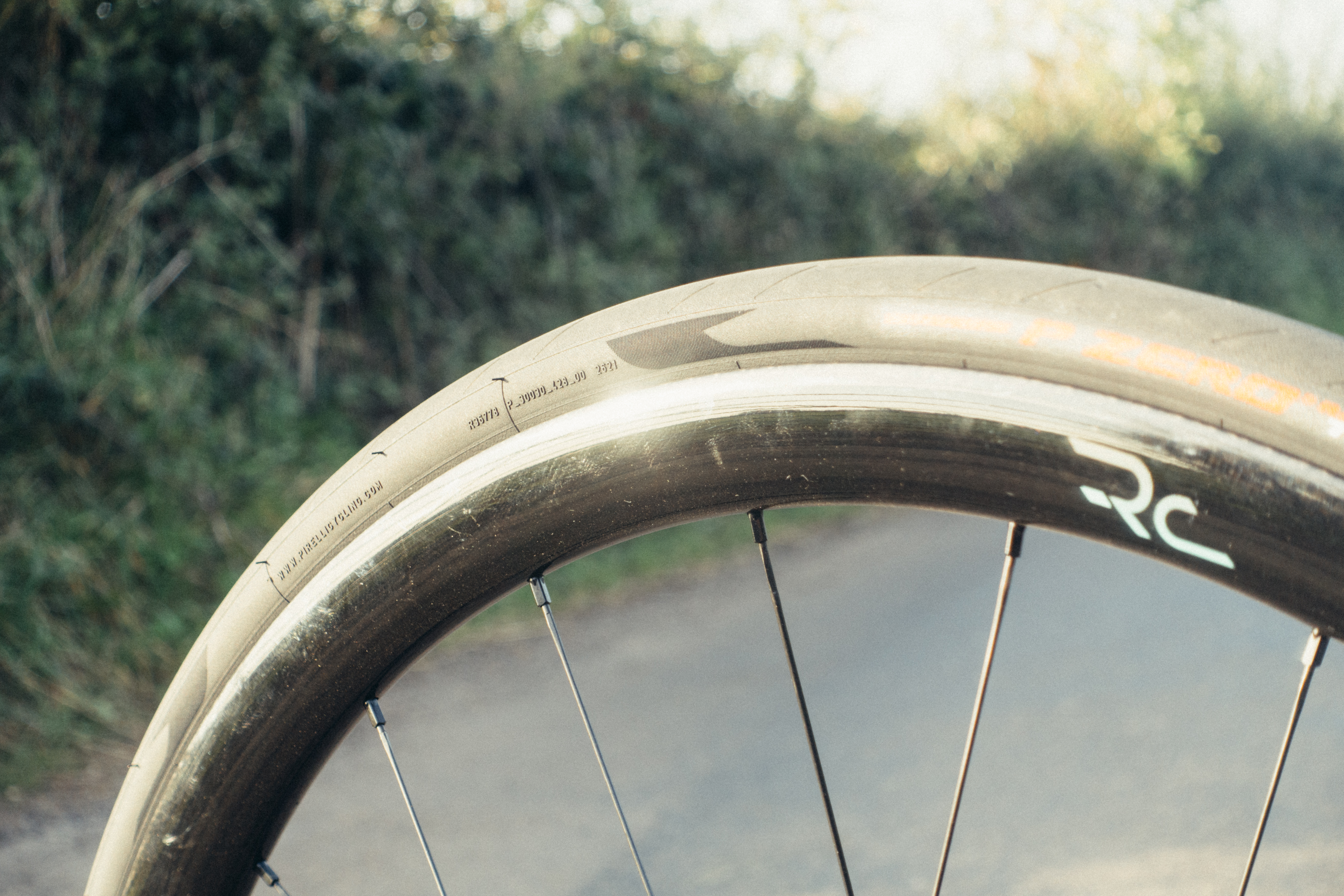
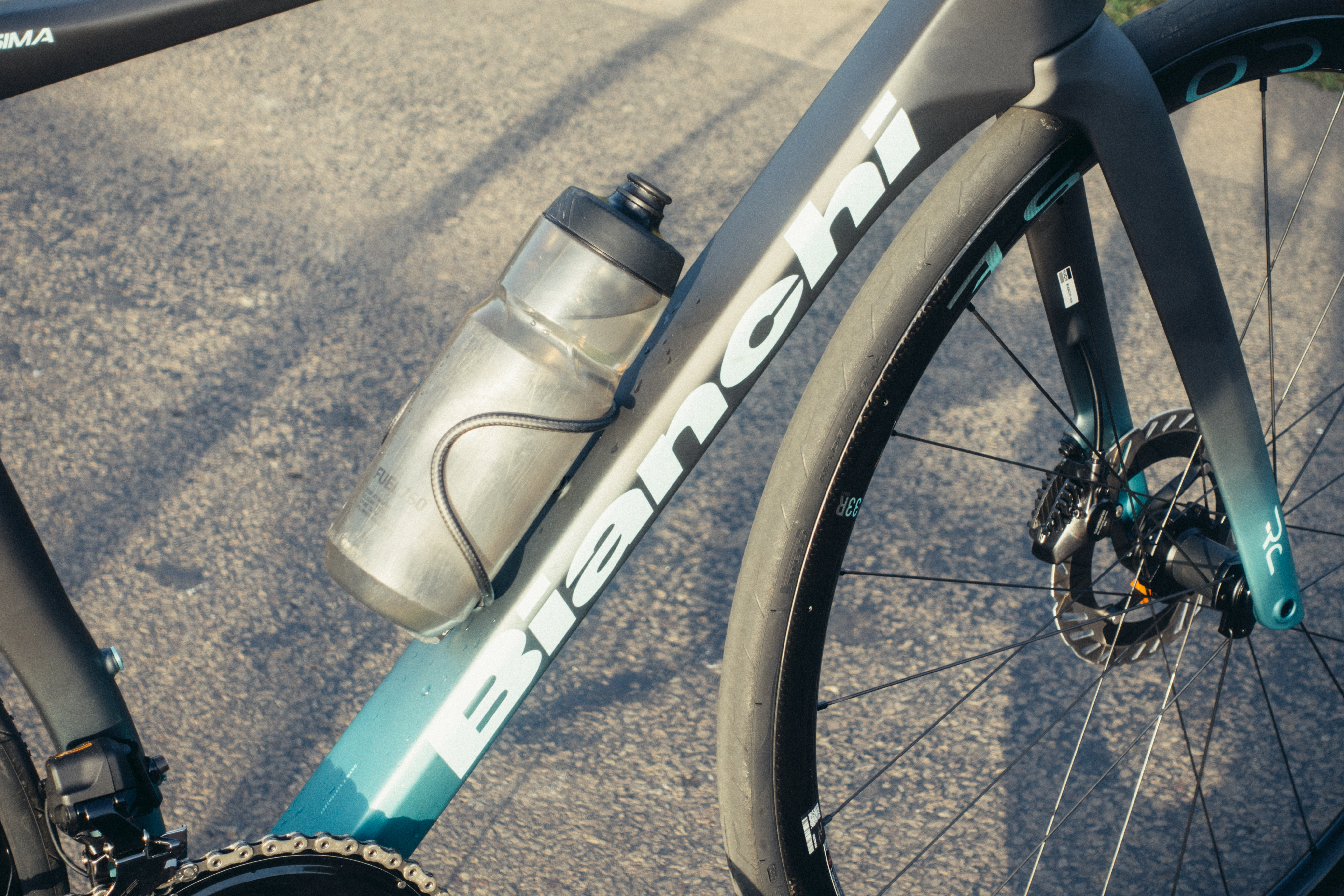
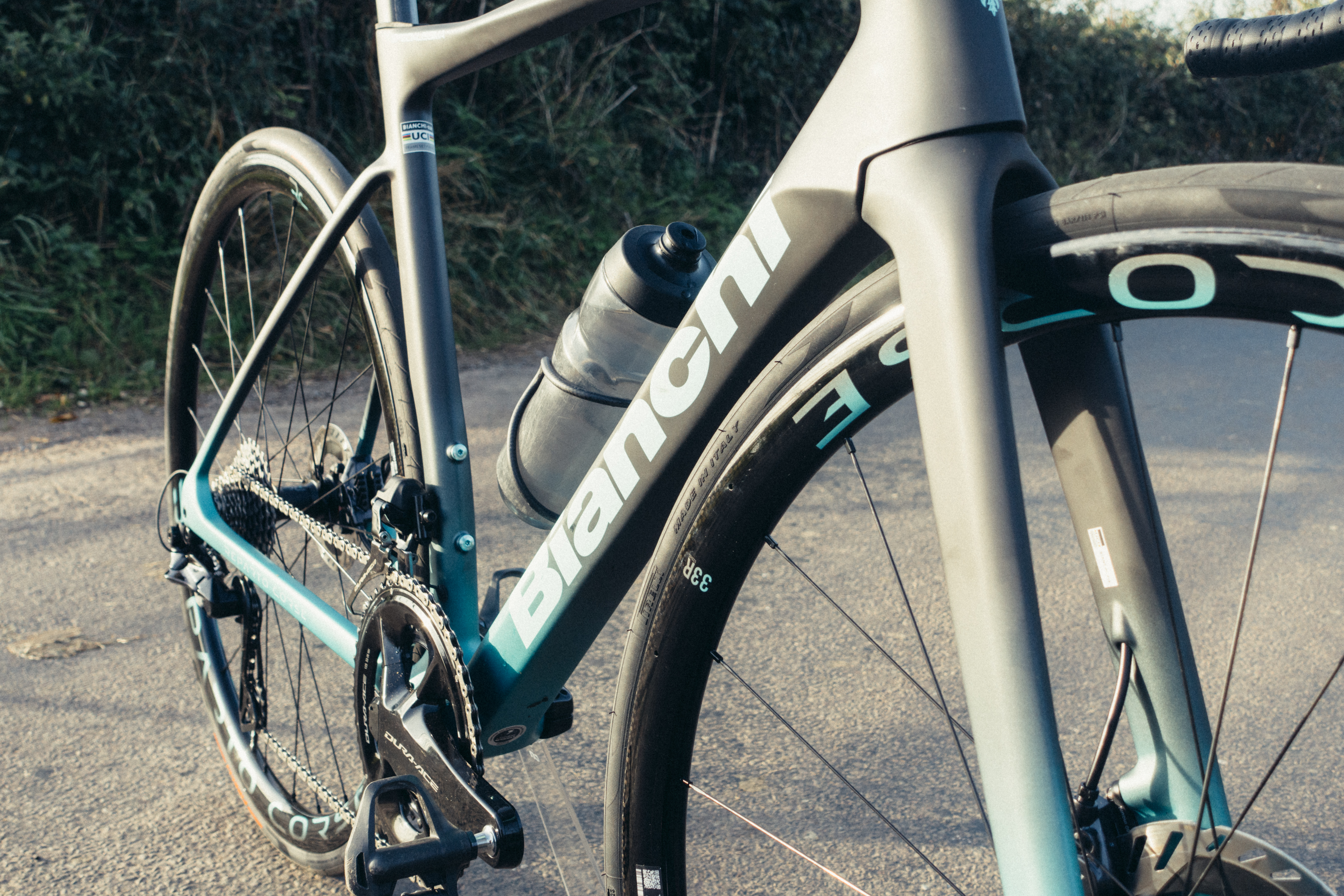
At the front of the bike aero trumps weight; the air is clean and undisturbed and it’s where the biggest gains can be had. A Reparto Corse integrated cockpit is an easy aero win, as well as being lighter than a combi system. Like the Tarmac, and also like the Pinarello Dogma and Pinarello F, there is a protruberance at the head tube in the form of a nose cone, designed in this case not only to break the air more easily, but funnel it down via an ‘aero sled’ down the front face of the downtube. Given I can’t empirically test aero claims I’ll just have to take any wattage savings as gospel. In this case the claims are based around a tipping point at which this bike becomes faster than an aero model, in terms of a gradient. Given the faster you ride the more aerodynamics factor in, this bike will be faster than the Oltre by a greater margin the slower a rider you are. In practice the tipping point is a gradient somewhere between 4% and 6% depending if you are a cycling journalist or a professional.
The latest race content, interviews, features, reviews and expert buying guides, direct to your inbox!
The swap to the brand's own wheels also has a part to play, with 33mm deep RC models weighing in at 1380g the pair, shod with 26mm Pirelli P-Zero TT tyres and latex inner tubes. It’s not as light a system as the new Factor O2 VAM, which clocks in at 6.2kg all in, but that’s firmly a bike aimed at being one of the best lightweight bikes.
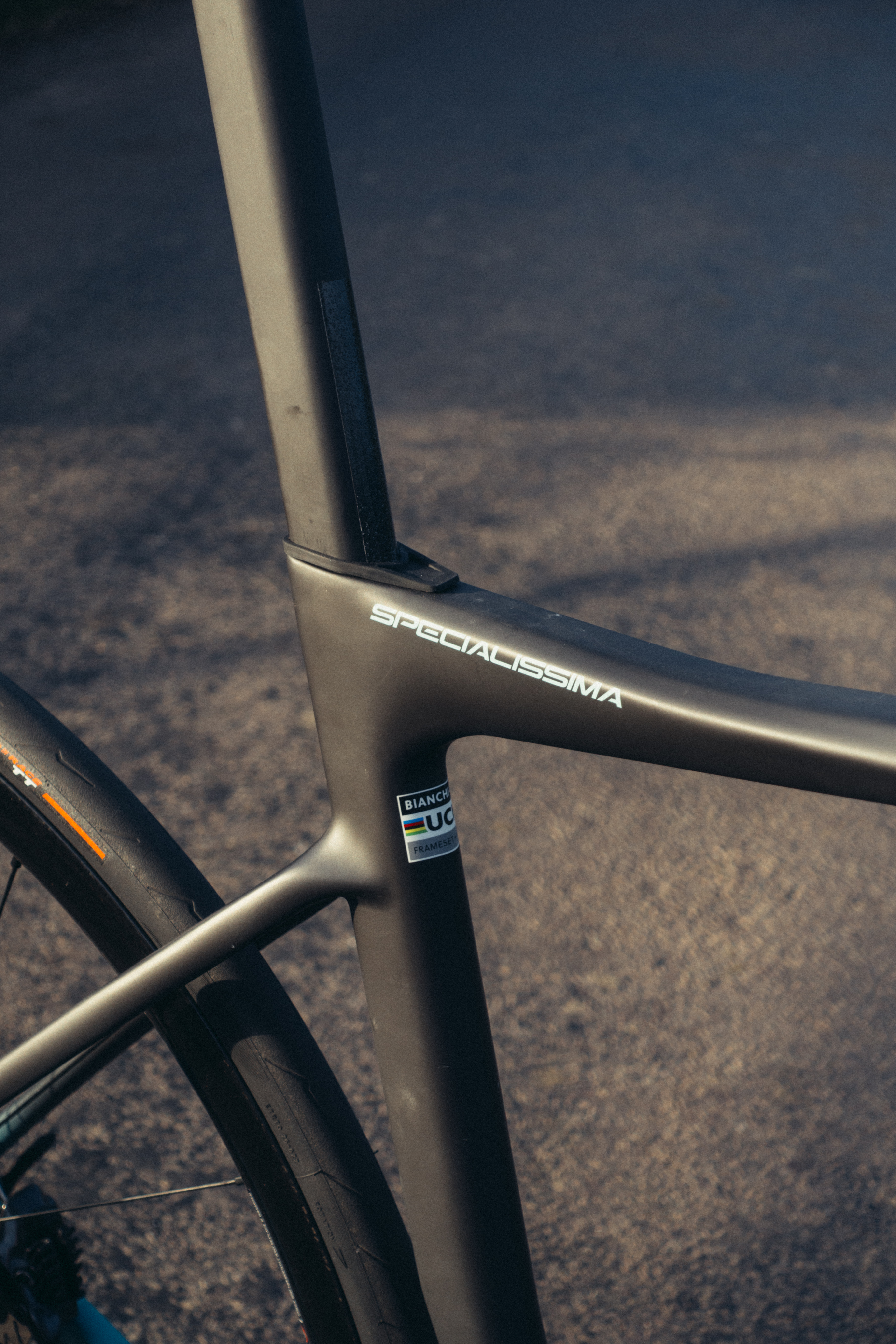
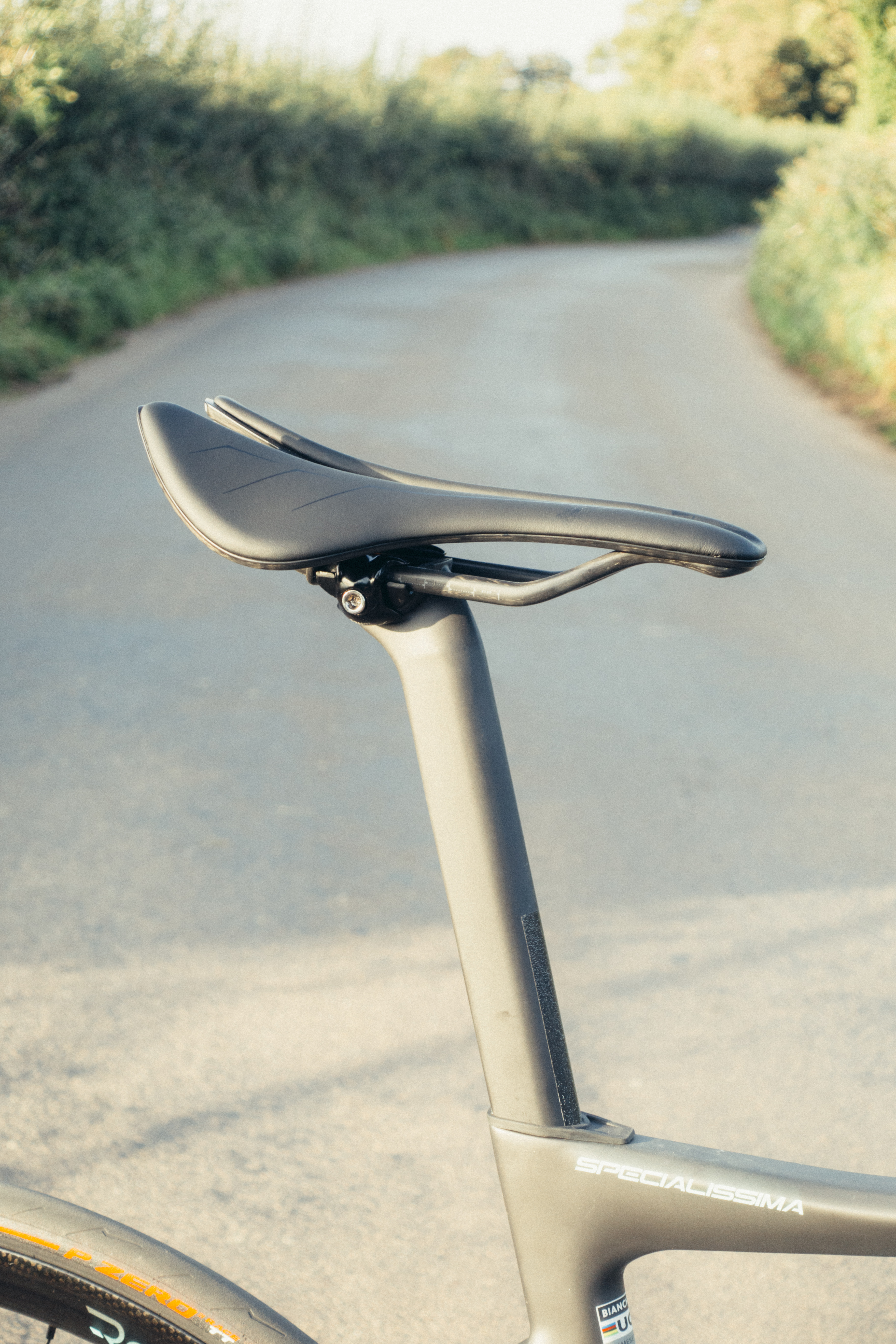
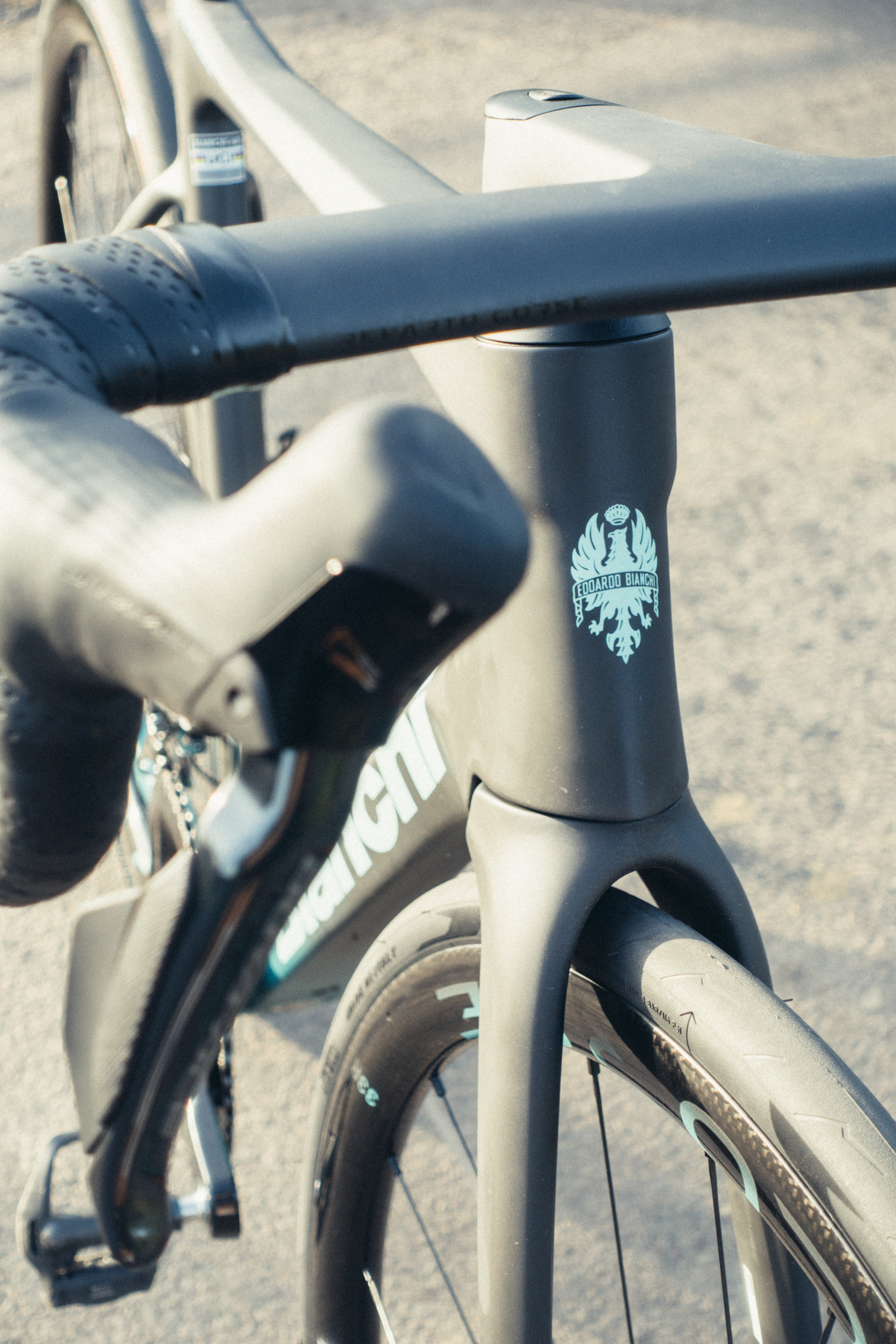
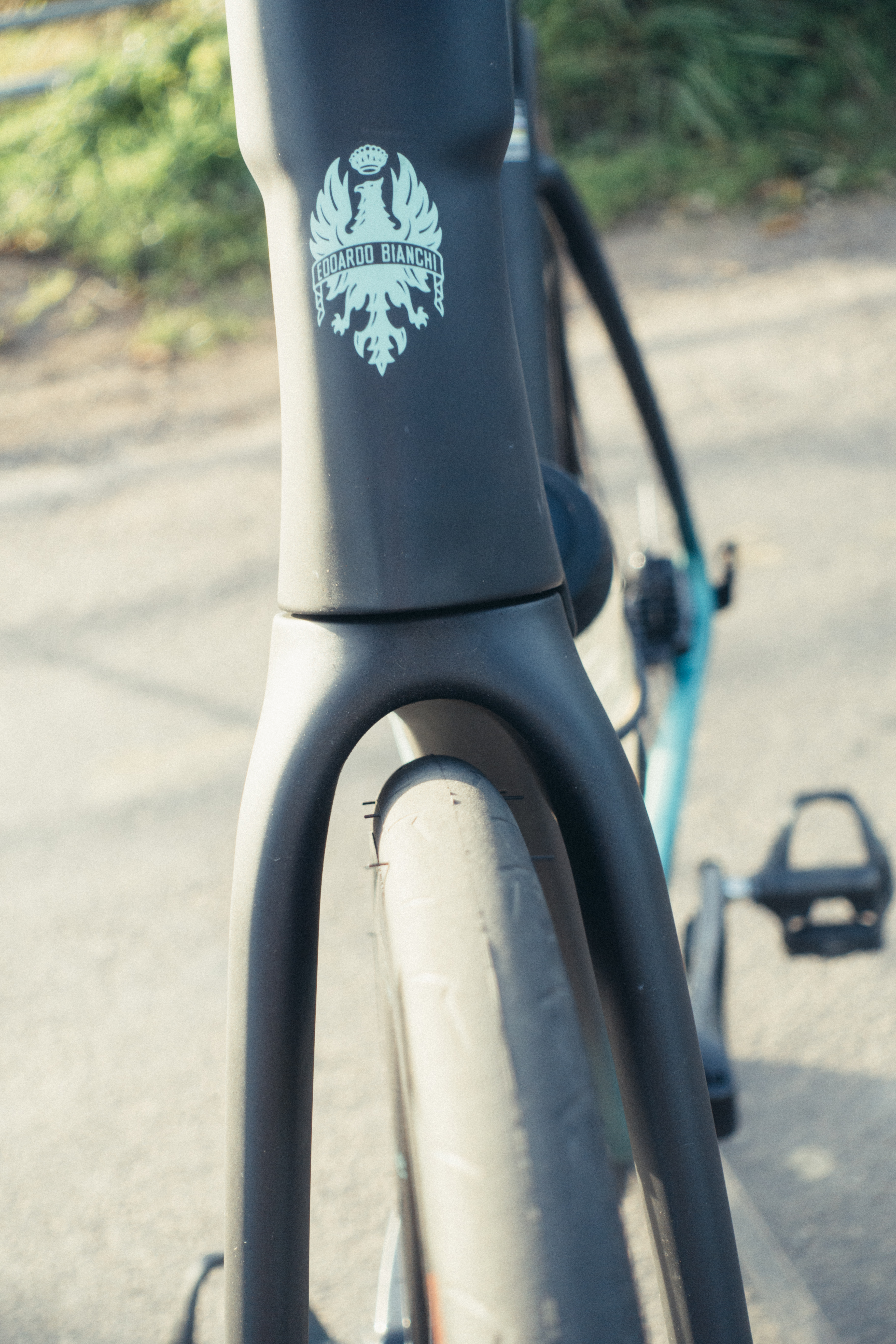
Performance
I will likely be a shock to nobody that a bike as low in mass as this climbs extremely well. I don’t really think that was ever in doubt, but as much as low weight makes a hell of a difference the geometry also has a part to play. The Specialissima in many respects feels a lot like the Canyon Ultimate insofar as you feel well and truly over the front of the bike. On shallow climbs this isn’t such a factor, but on steeper ones it is. Personally I’d like to see an in-line seatpost, rather than a setback model, to really lean into the position, but I managed just about fine by slamming the saddle all the way forwards. The saddle, despite being furiously uncomfy in jeans on the way home from the office that once, is surprisingly pleasant despite being limited in terms of padding; the upwards scoop at the back really helps limit movement when driving along on the flat.
Climbing prowess aside, which I don’t think is really the acid test of a modern lightweight bike, there’s the drag coefficient to consider. The Specialissima really does feel like an aero bike in terms of the speed in a straight line, and on shallower climbs. This is aided by extremely fast rolling wheel bearings and extremely fast TT tyres. Tucked up, elbows in, and giving it both barrels from the saddle was a pretty joyous experience. What was unusual was that, while feeling like an aero bike in terms of drag, it lacked the inertia of those dedicated wind-cheaters. When opening up a sprint on a climb from a fast rolling start I found myself needing to be in one harder gear than I was used to, so easy was the acceleration. Conversely the effort needed to maintain momentum wasn’t necessarily harder, but the ride felt much less stolid. Each pedal revolution seemed to create subtle changes in velocity, rather than a constant pace. It would pick up speed less quickly downhill, though the terminal velocities were unchanged.
This slightly jittery ride feel borne out of the low weight is amplified by the handling characteristics. As per the climbing, the handling most closely matches the Canyon Ultimate, but here the weight is notably lower and so it doesn’t handle sudden gusts of wind with as much composure. This is further compounded by the tyres; 26mm TT tyres are a sure fire way to add straight line speed, and reduce the weight, but they really do struggle in the corners, and I don’t feel like I could fling it around bends as hard as it deserved. While a lot of my testing was on greasy roads, even on dry days they don’t inspire confidence.
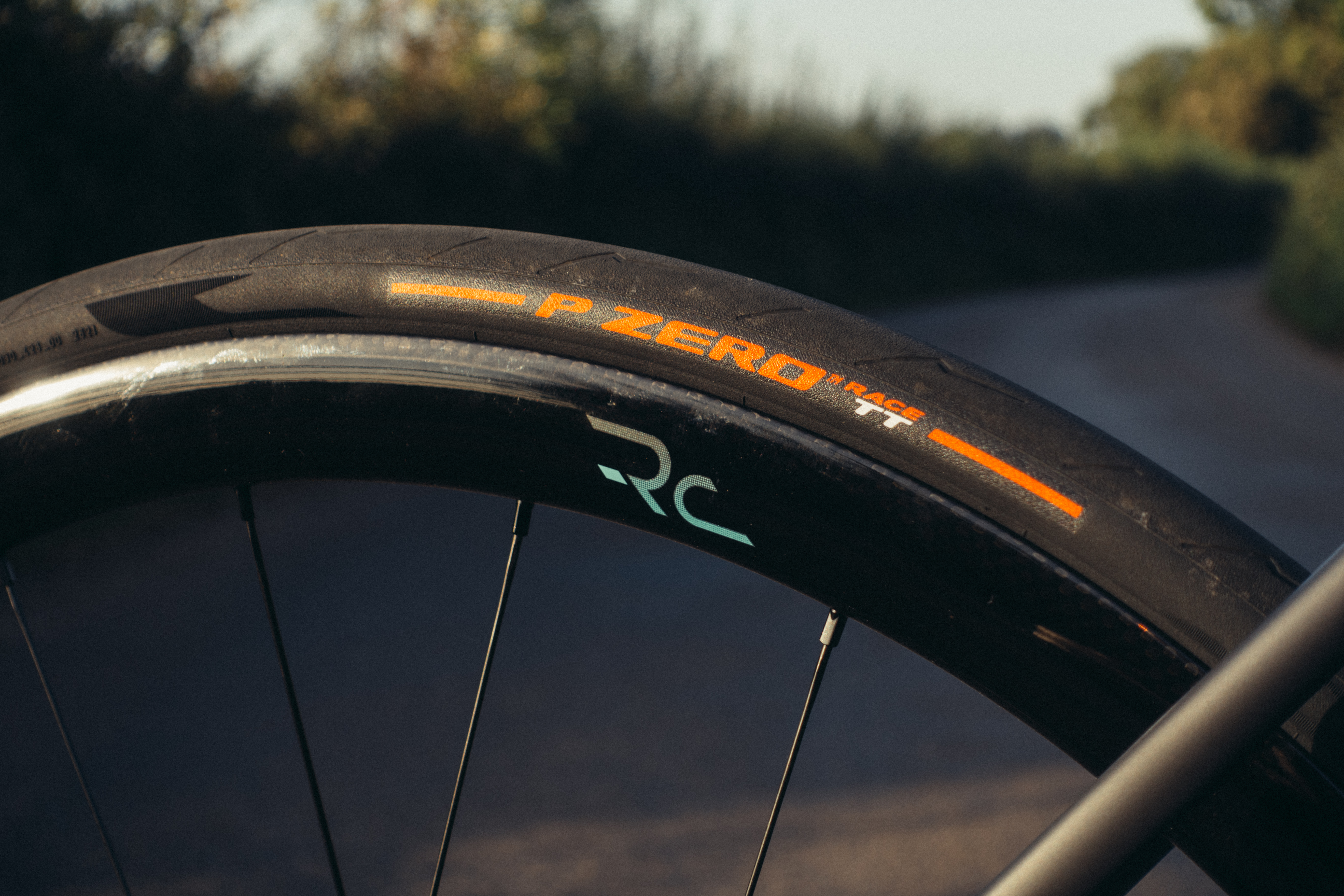
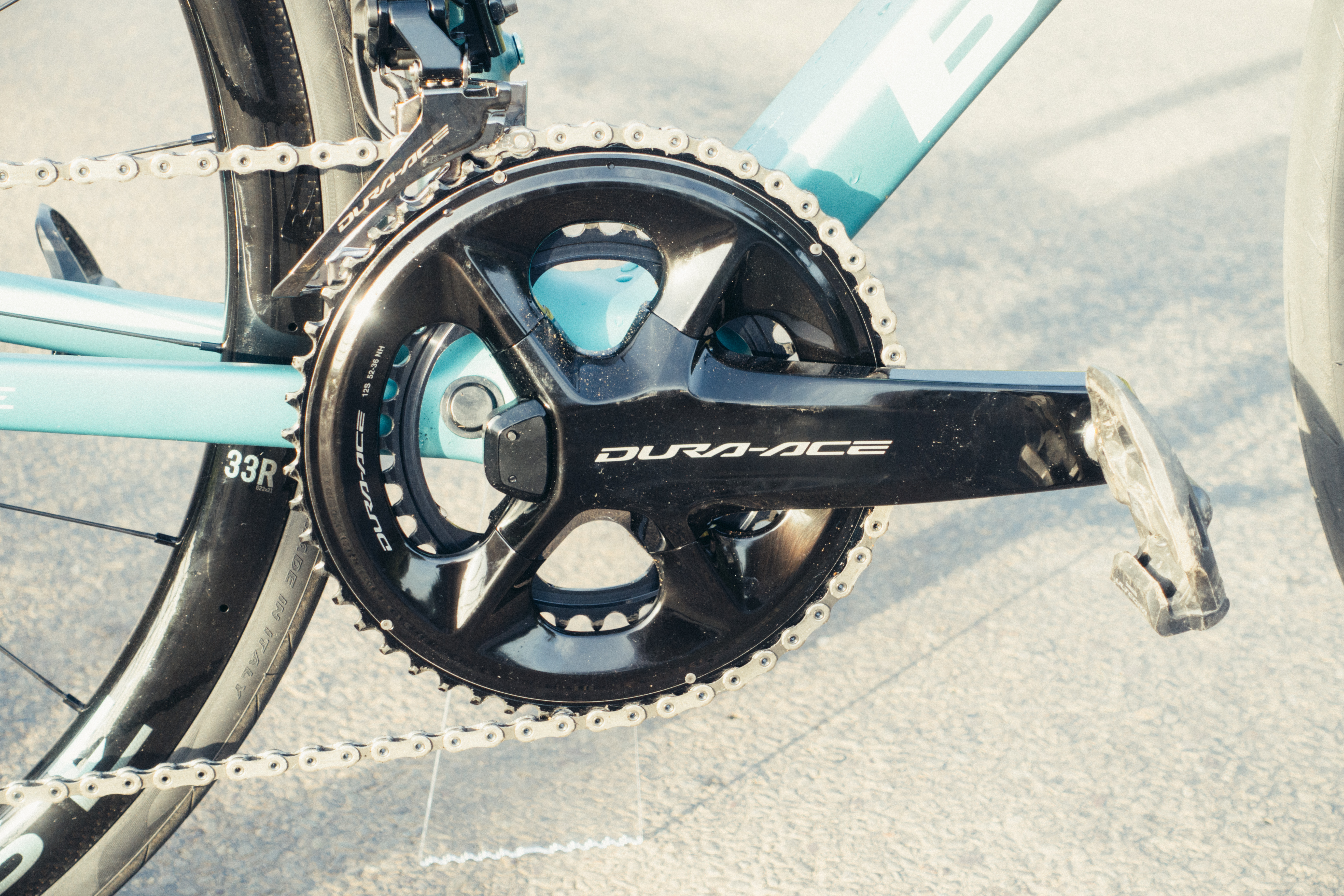
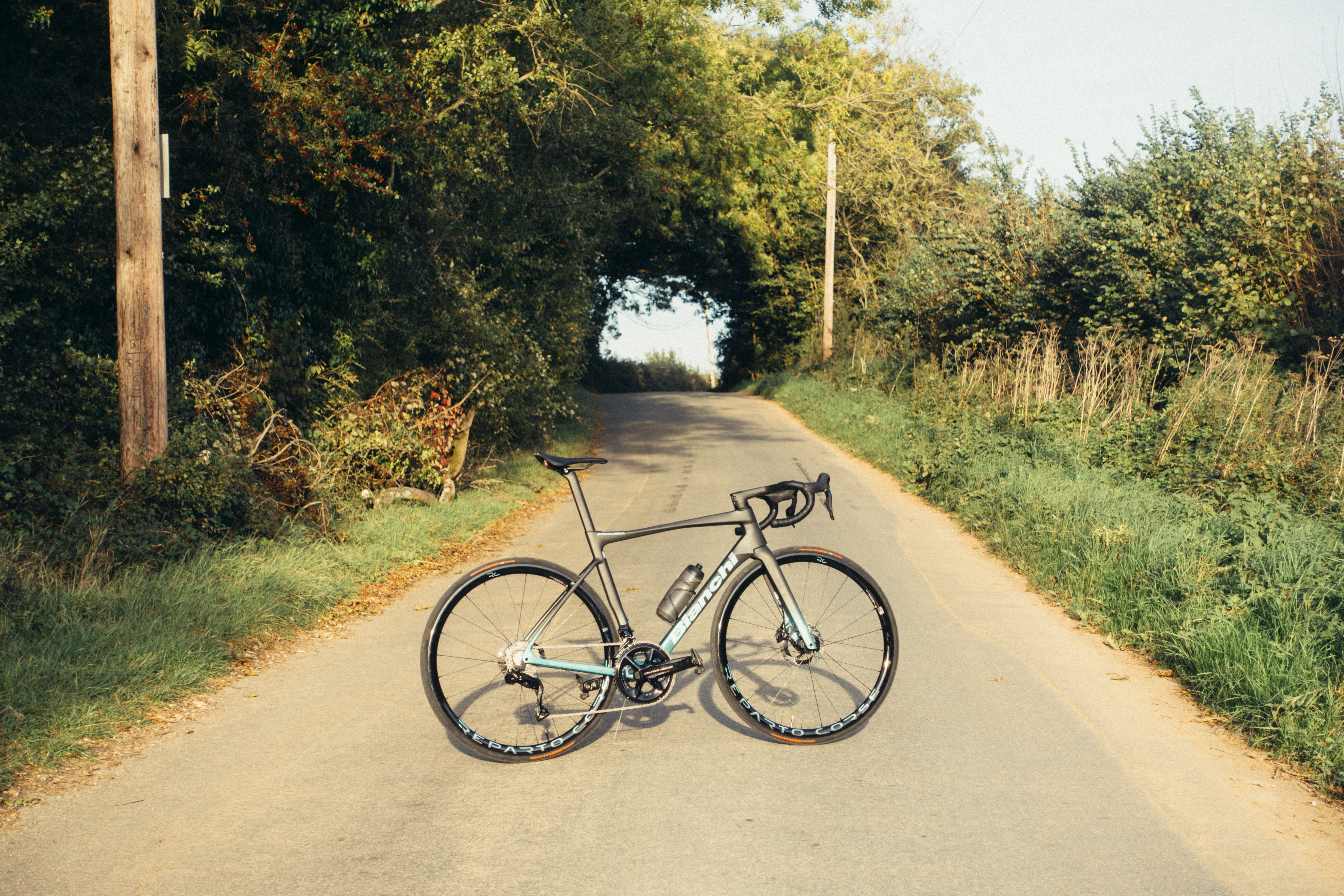
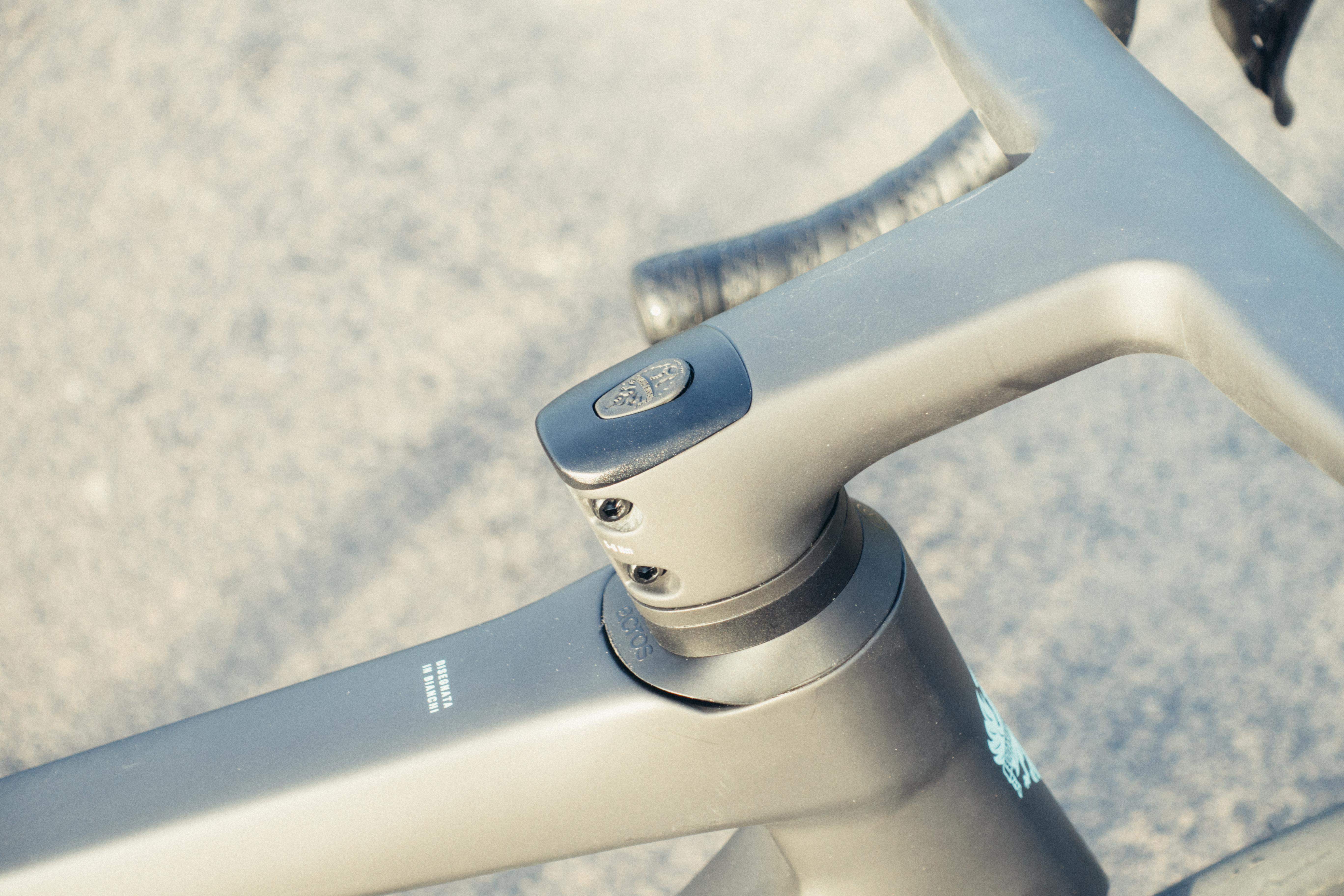
I don’t much go in for stats when I ride. I only use a computer when I need navigation, but by the numbers this bike is certainly no slouch. Yes, personal fitness and weather fluctuations and all sorts of things play a part and it’s far from repeatable, but being able to hold 31km/h for 70km on my own in pretty grim weather is a testament to the pure performance of this machine.
And this gets me to the nub of the bike. It feels like Bianchi is at something of a crossroads in terms of brand identity. It is, like so many Italian bike brands, steeped in history like so many sponge fingers soaked in coffee liqueur before making a tiramisu. Colnago makes much of its history, continuing to make its steel heritage models, as well as having the C68 made by hand in Italy as I saw in my Colnago factory tour. Bianchi seems to be, with this much more than the Oltre, setting its sights on performance above all else. Compared to the C68, and the Tour-winning Colnago V4Rs, which felt slightly old fashioned in its geometry (because to change the geometry of a Colnago is akin to asking the Pope to convert to Hinduism), there is a distinct lack of that intangable Italian heritage.
It doesn’t look like a Bianchi. There’s nothing insane like basing the seat tube angle off the founder’s mother’s height, or the bottom bracket drop off the first step of the staircase at the Vatican. Only the hint of that Celeste green gives harks back to days of yore. It would almost look more natural with an Argon18 logo on the downtube
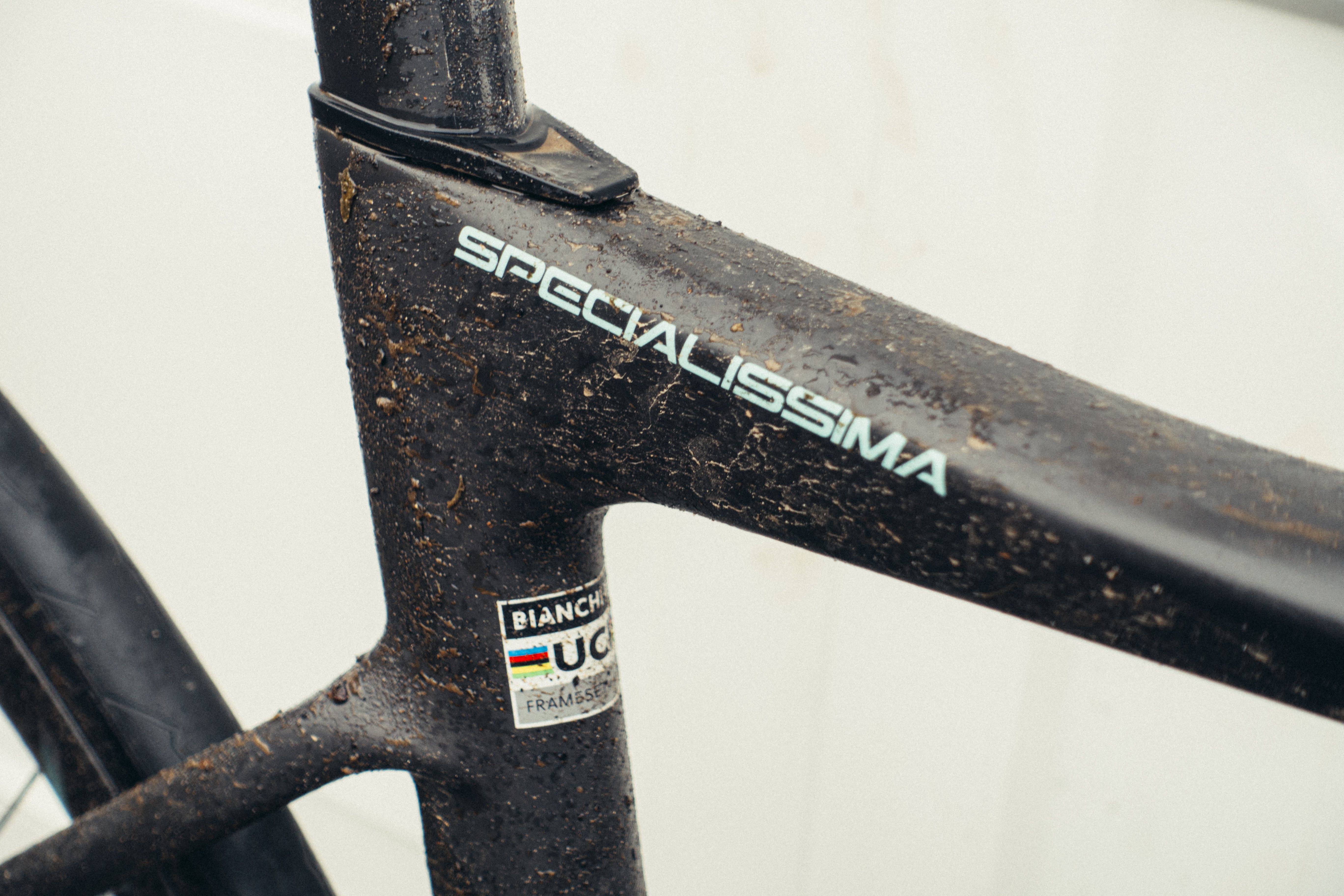
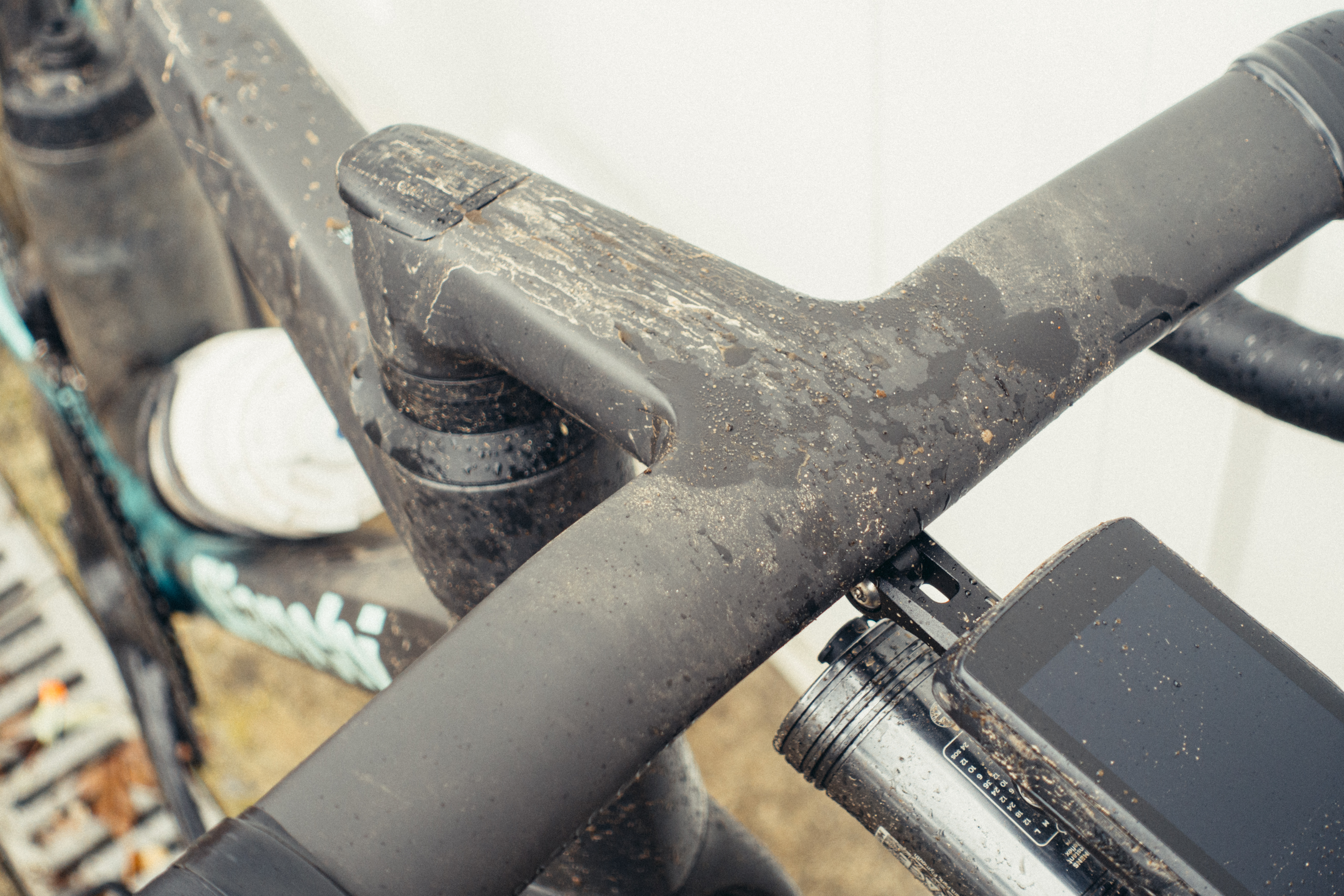
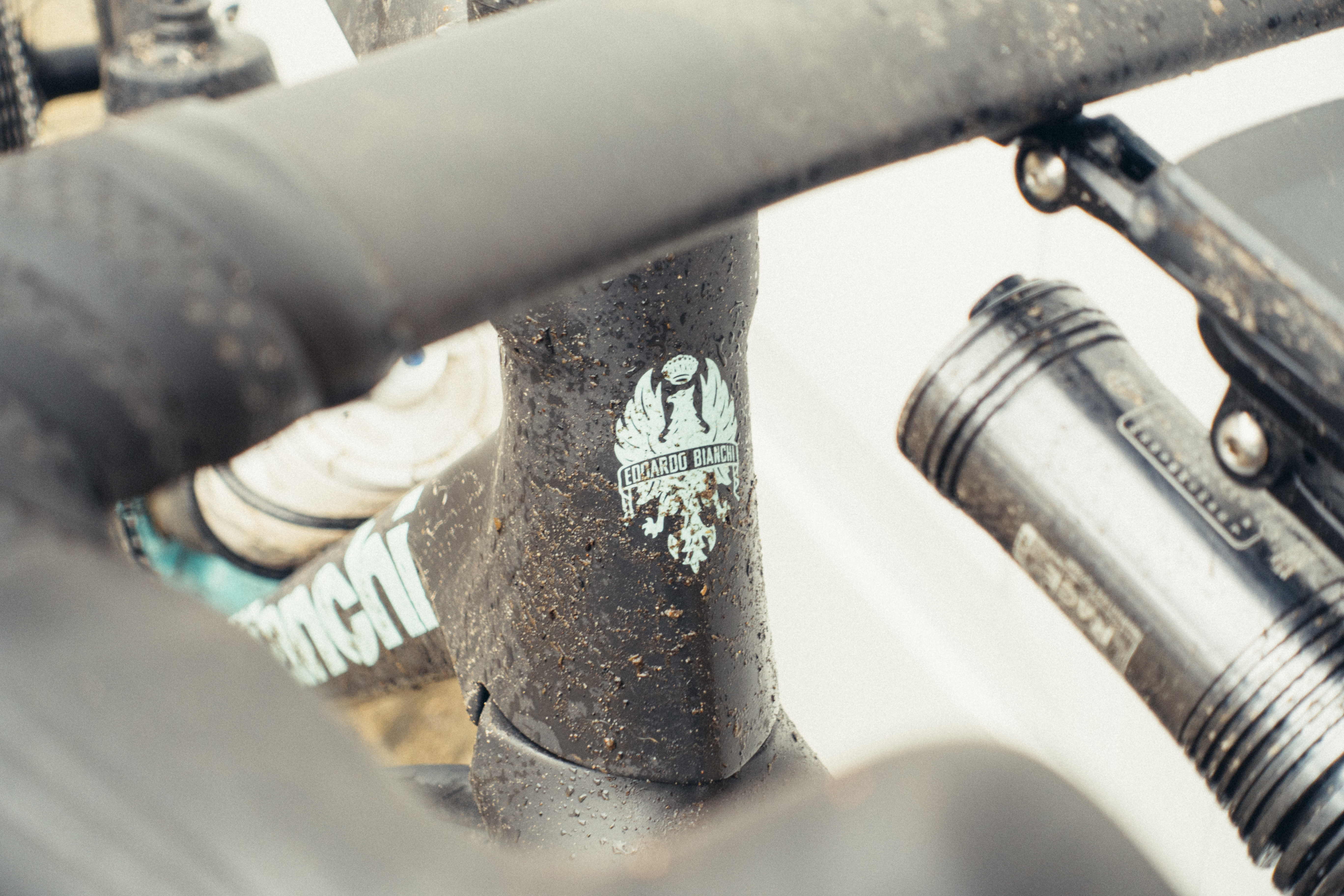
Value
If you’re splashing €12,749 on a bicycle you either want the absolute best performing machine, or you want people to know you spent €12,749 on a bicycle. Bikes in this price bracket are as much status symbols as they are sporting tools and to suggest otherwise is naive. The acid test for this is the cafe stop; while a similarly priced Colnago C60, bedecked with Super-Record and the new Campagnolo Hyperon wheels had gathered a small crowd by the time I came back outside with my espresso and cake, the Bianchi had batted not a single eyelid. If out and out performance is your goal then it’s absolutely a worthy use of money. It is shockingly fast, and although I wasn't enamoured with the tyre choice, taken in the context of the price tag as a whole slapping a set of 28mm GP5000’s isn’t going to break the bank.
If you are placing the value on this as a status symbol though then I suggest you look elsewhere. I was really torn on this bike until my final test ride. I almost wanted it to be worse; to be cliched and flawed and Italian and a bit more… mad. If you’ll permit me a departure into a football metaphor for a second, the final test ride was like asking Inter Milan to play 4-4-2 away against Plymouth Argyle in January. Rainy back lanes and pot holes half full of silt and horse muck are a world away from the mountains north of Milan, and while it’s not necessarily what this bike was designed for, it managed to eke out a tough win; it won me over in extra time because of just how dialled it felt at full chat. The tyres let it down, it’s not mental, but it’s incredibly fast and so in that context alone it feels like it justifies its pricetag in a more tangible sense compared to more heritage-focussed competitors.
Or in other words, to coin a popular footballing phrase: Can it do it on a cold, rainy night in Stoke? Yes it can, with a swap of the tyres.
While Bianchi is fresh at the WorldTour table, this bike is one that, should the brand choose to sponsor a larger team, absolutely deserves its seat, and ask for seconds. It's in the same price bracket as other top flight race bikes, and while I wouldn't necessarily say it's a bargain, it's far from over the top.
[I must also give a shout out to friend and professional rival Adam Becket of Cycling Weekly who helped me with my football metaphor, because it is a world away from my comfort zone]
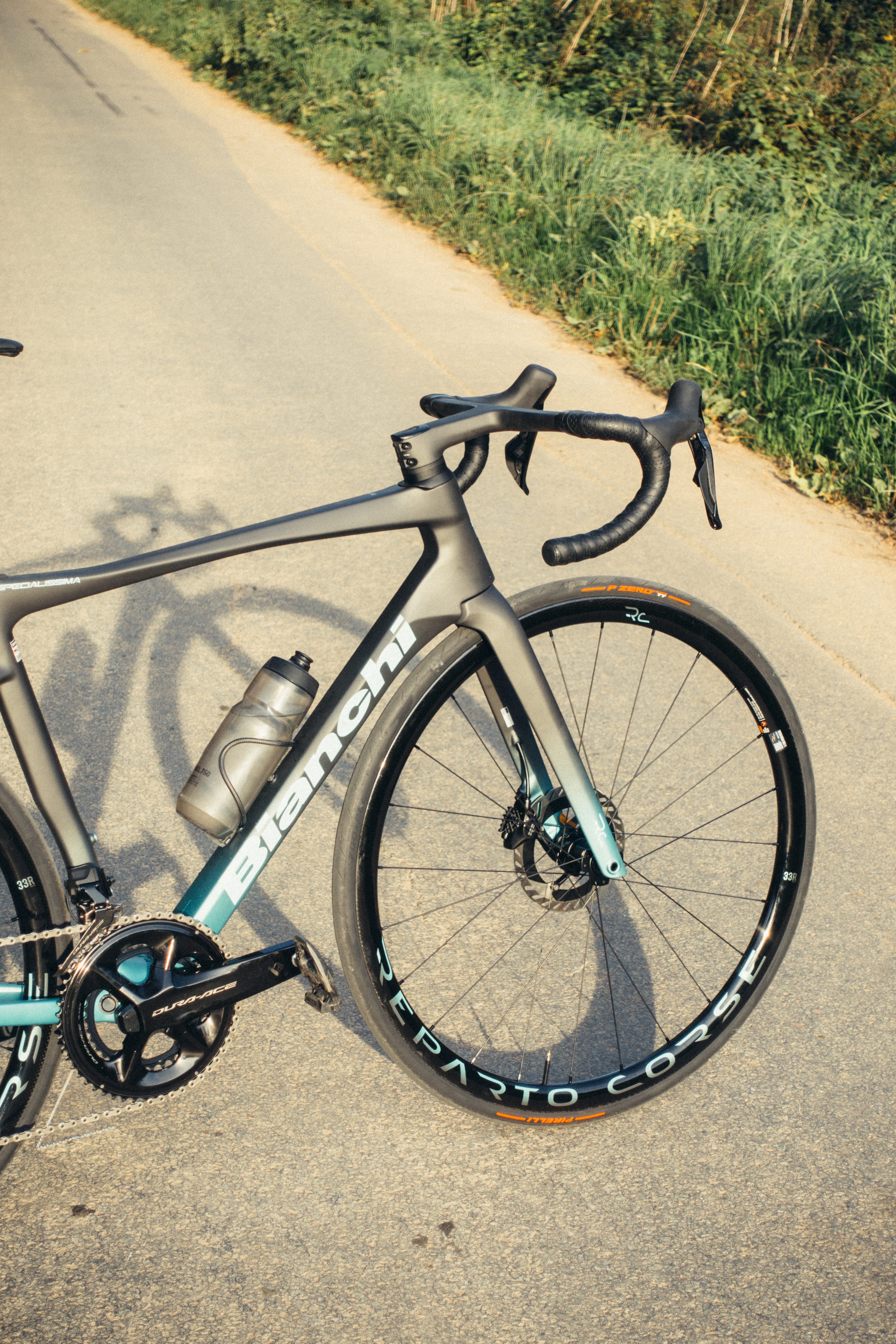
| Row 0 - Cell 0 | Row 0 - Cell 1 | Row 0 - Cell 2 |
| Row 1 - Cell 0 | Row 1 - Cell 1 | Row 1 - Cell 2 |
| Row 2 - Cell 0 | Row 2 - Cell 1 | Row 2 - Cell 2 |
Verdict
In terms of pure performance, this is a sensational bike. Fast handling, fast riding, incredibly rapid uphill, and only really let down by the tyres, which in their defence are sufficiently speedy as intended (time trialling, preferably in a straight line in the dry), I just value grip more than pure speed.
It's a world class bike, worthy of a WorldTour team, the sponsorship of which I feel would help cement this new direction that Bianchi feels like it’s going in.
If you want a bike to show off in Richmond Park then I suggest you spend your money elsewhere, but if you want a bike that’ll help you take the Richmond Park KOM/QOM (I presume there must be one?) then it’s definitely worthy of your consideration. You can probably get as fast a package by spending a bit less money, but it certainly feels like a more tangible justification of its price tag than its competitors.
| Attributes | Notes | Rating |
|---|---|---|
| Design and aesthetics | On balance I like the silhouette, but the gloss wheels and the 'Reparto Corse' logo are a turn off | 8/10 |
| Build | The only real flaw for me are the tyres; while fast they hold it back in the corners, but an easy swap nonetheless for a bike of this price | 9/10 |
| Performance | A little jittery sometimes, especially in the wind, but crazy fast more or less everywhere | 10/10 |
| Weight | It's not quite class-leading but it's UCI illegal so it's hard to mark down here | 10/10 |
| Value | It's expensive, but it's in the same ballpark as other top-end race bikes and holds its own in such company | 8/10 |
| Overall rating | Row 5 - Cell 1 | 90% |

Will joined the Cyclingnews team as a reviews writer in 2022, having previously written for Cyclist, BikeRadar and Advntr. He’s tried his hand at most cycling disciplines, from the standard mix of road, gravel, and mountain bike, to the more unusual like bike polo and tracklocross. He’s made his own bike frames, covered tech news from the biggest races on the planet, and published countless premium galleries thanks to his excellent photographic eye. Also, given he doesn’t ever ride indoors he’s become a real expert on foul-weather riding gear. His collection of bikes is a real smorgasbord, with everything from vintage-style steel tourers through to superlight flat bar hill climb machines.
